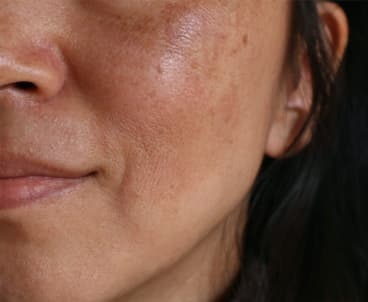 VI Peel
VI PeelEverything You Need To Know About Pigmentation On The Body
And the tools of the trade to treat it.
We often fall into the trap of forgetting that the face isn’t the only part of the body that has skin that needs care. As such, the face is not the only area that experiences unwanted pigmentation. Truth be told, this unwanted side effect of excess melanin production can happen anywhere from head to toe. From the armpits to the inner thighs and even the stomach, discoloration likes to call these areas home, but the reason for its existence isn’t quite as simple as one may think. Struggling with hard-to-erase patches of pigmentation on the body that seem to appear out of nowhere? You’re not alone. Here’s what you need to know about treating discoloration on the skin below the neck.
Color Theory
Every skin tone contains melanin — it’s what gives pigment to the skin. Some of us naturally have more or less melanin than others, which is where darker and lighter skin tones come into play. An overproduction of melanin leads to hyperpigmentation anywhere on the face and body. Most of us are familiar with how hyperpigmentation affects the face, but discoloration can occur from the neck down, too.
Simply put, hyperpigmentation is nothing more than an increase of melanin, the natural pigment in the skin, eyes, and hair. The overproduction produces patches and spots on the skin that are darker than the skin’s natural complexion. Hyperpigmentation on the face and body are similar in that they manifest as areas of discoloration on the skin. However, certain types of pigmentation are more likely to occur in certain areas, says Dendy Engelman, MD, a board certified dermatologist and Mohs surgeon in New York City.
Generally speaking, there are three main types of hyperpigmentation on the skin:
- Sun Spots: Also known as ‘liver spots,’ or ‘lentigines,’ they arise due to excessive sun exposure. The face, hands, chest, and arms are commonly affected, and they are more likely to occur in lighter skin tones.
- Post-Inflammatory Hyperpigmentation (PIH): PIH can form as a result of any inflammation or irritation to the skin. It is most common in the areas where acne forms, like the face, back, and shoulders. “If you notice a new dark spot where you recently had a pimple, it is likely due to post-inflammatory hyperpigmentation,” Dr. Engelman shares.
- Melasma: The most ambiguous of the bunch, melasma is believed to stem from genetics and hormonal changes (think: pregnancy, medication). It can occur anywhere on the body, though the face and stomach are typical locales for the brown blotches.
Especially as it relates to dark spots on the body, it’s important to talk about the difference between hyperpigmentation and birthmarks or moles. “Birthmarks and moles may be raised, which can indicate that they are not another form of hyperpigmentation, although often they look identical,” Dr. Engelman admits. “If you notice a new dark spot that seems abnormal, visit your dermatologist to get it checked out since skin cancer can also look like a birthmark, mole, or hyperpigmentation but is extremely dangerous and can be fatal.”
The factors that cause discoloration on the face are the same as those that produce it on the body. With that said, facial skin generally produces more melanin than body skin does. But that's not all. Certain body parts have different melanin levels than others, says celebrity aesthetician Natalie Aguilar. Discoloration from one body part to the next can vary in color, even when exposing the body to the same trigger equally.
Furthermore, the face is also one of the areas most likely to be exposed to the sun. As a result, it can have more potential for damage and, in turn, hyperpigmentation. But, of course, that doesn't mean that the neck down is immune to unwanted discoloration — it's not. Marisa Garshick, MD, a board certified dermatologist in New York City, says that, because the skin on the body tends to be thicker, any of the hyperpigmentation involves the deeper layers of the skin. That means it can take longer to fade.
Since no two bodies are the same, no two cases of body hyperpigmentation are either. Hyperpigmentation can occur in all skin tones but is more common in darker skin due to increased melanin. “When an injury occurs to the skin, it can stimulate melanin production, which leads to hyperpigmentation,” Dr. Garshick shares. “Additionally, some hormonal triggers can worsen or trigger hyperpigmentation, as seen in the setting of pregnancy and with some oral contraceptives.”
How Well Do You Know Your Skin?
There's no denying the importance of regular (read: at least annual) in-office skin checks with a board certified dermatologist to identify and keep tabs on any skin changes. That goes for dark spots and patches, too. Anything from hyperpigmentation to precancerous sites can be discovered during these appointments and then appropriately treated. “If the discoloration is associated with thickening of the skin, it should be discussed with a doctor to ensure there are no other contributing factors,” Dr. Garshick advises.
As we’ve established, hyperpigmentation can occur anywhere on the body and is primarily due to injury or inflammation. Body parts with folds tend to contain more melanocytes, but the most common areas of the body that are home to hyperpigmentation include:
- The Underarms: Aguilar says that hyperpigmentation in the underarm area is usually genetic, although irritation from repeat shaving, plucking, and deodorant may stimulate it. To reduce friction when shaving, always use thick, moisturizing shaving cream (we like Pacific Shaving Co. #ShaveWithPurpose) and a fresh, clean razor blade.
- The Inner Thighs: Tight pants that cause friction and chaffing can lead to discoloration in the thighs and even stretch into the bikini line and groin area. Along with sun exposure, hormonal imbalances and changes and even some types of birth control can cause a darkening of the skin in these areas.
- The Buttocks: Darker skin tones tend to develop dark patches of skin and dark spots on the butt, which is a high-friction area that is prone to rubbing.
- The Neck: Normally found on the back of the neck, darkness can result from the sun or hormonal disorders. Marks on the front of the neck are usually more in line with what you experience on the face and décolleté.
- The Stomach: Technically known as the linea nigra, many pregnant women develop a vertical line running from as high as under the breast fold down towards the belly button and beyond. After childbirth, the linea nigra usually begins to lighten up around the four- or five-month mark. Melasma is also possible on the abdomen.
- The Chest: One of the most open and exposed areas to the sun is the chest, which is why sun spots like to take up residence here. On average, Dr. Engelman says people start to see body hyperpigmentation in the form of sun spots around age 40. “It can vary from person to person based on the amount of melanin present in the skin and how much sun exposure they have had,” she shares.
Thanks to sun exposure alone, entirely preventing hyperpigmentation is hard (if not impossible). But there are steps you can take to minimize the risk. For starters, wear sunscreen every day on all exposed areas of skin (we’ve got a roundup of dermatologist picks for face and body). Additionally, don't pick or scratch at the skin, as this can cause new discoloration or worsen existing spots. Finally, avoid using products on the skin that are irritating or photosensitizing (without protection), as they can trigger a reactive response.
Creating a Clear Slate
As with any skin condition, the first step in treating hyperpigmentation is identifying the root cause of the problem. From there, it’s best to implement (with the help and recommendations of your dermatologist) a plan of attack over the course of at least three months, if not longer. Dr. Garshick says that the thickness of the skin on the body may make it harder for certain ingredients to work as well or as quickly as they do on the face. But, with patience, they can still be effective. “It is important not to be tempted to use too much of certain ingredients, like retinoids or exfoliating acids, even though the skin may be thicker,” she cautions. The reason? More irritation means more chances to exacerbate pigmentation.
While the length of time it takes for discoloration on the body to resolve varies from one person to the next, some find that it takes longer for post-inflammatory hyperpigmentation to fade from the body than the face. It is also important to remember to be as diligent about sun protection when PIH involves the body as you are when it involves the face, Dr. Garshick says. “This is because the more sun exposure, the darker the area may become and the slower the healing time,” she shares. “Without sunscreen, the hyperpigmentation can worsen and take even longer to fade.”
Aguilar says effective ingredients for treating body hyperpigmentation include topical niacinamide and alpha hydroxy acids (think: glycolic and lactic). “Glycolic acid helps to expedite the shedding of dead skin cells and reveal brighter and newer cells,” she explains. “Lactic acid also helps exfoliate old, dull skin cells on the skin's surface by dissolving the bonds that hold them together.” Both AHAs can be used as part of a skin-brightening plan since they are some of the gentler ones available. Niacinamide (a.k.a. vitamin B3) helps fade existing hyperpigmentation by decreasing inflammation and the redness associated with discoloration while providing antioxidant protection, too.
Other proven skin brighteners include vitamin C and retinol. “These ingredients – and niacinamide – work together also to fight other symptoms of aging skin and give the skin an overall healthier, younger appearance,” Dr. Engelman says. Hydroquinone is a more complicated brightening agent, while alpha arbutin is a less controversial alternative. Dr. Engelman's picks include the Glo Skin Beauty Hydra-Bright Alpha Arbutin Drops, which is made with lactic acid and alpha-arbutin to brighten and gently exfoliate, and the SkinCeuticals Advanced Pigment Corrector, a lightweight lotion formulated with a non-toxic hydroquinone derivative called hydroxyphenoxy propionic acid.
Body exfoliating washes and lotions are important to incorporate, too. Most contain exfoliating AHAs to help brighten the skin and fade unwanted discoloration. For a more intense exfoliation, Dr. Engelman suggests chemical peels and chemical exfoliants to remove the epidermis (the top layer of the skin) and hyperpigmentation over time. “This is not a quick fix, and it requires multiple treatments for best results,” she shares. “But hyperpigmentation will improve over time.”
All products featured are independently selected by our editors, however, AEDIT may receive a commission on items purchased through our links.
More Related Articles
Related Procedures

AI Plastic Surgeon™
powered by'Try on' aesthetic procedures and instantly visualize possible results with The AI Plastic Surgeon, our patented 3D aesthetic simulator.


